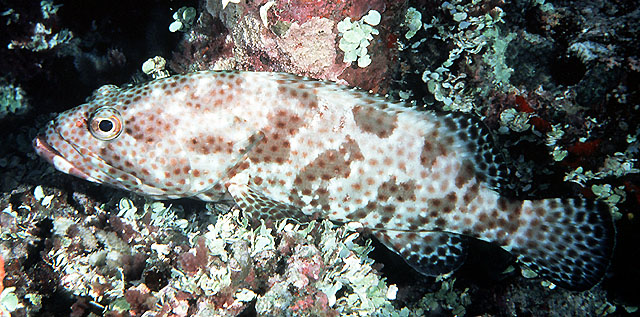| Serranidae (Sea basses: groupers and fairy basslets), subfamily: Epinephelinae |
| 100 cm TL (male/unsexed) |
|
reef-associated; depth range 1 - 300 m, oceanodromous |
| Indo-Pacific: Red Sea to South Africa and eastward to Ducie in the Pitcairn Group, north to Japan, south to New South Wales and Lord Howe Island. Migration report from the eastern Mediterranean Sea (Ref. 6489, 5385) may be based on Epinephelus coioides specimens. |
|
Dorsal spines (total): 11-11; Dorsal soft rays (total): 13-16; Anal spines: 3-3; Anal soft rays: 8-8. Color of head and body pale greenish grey or brown with round dark spots that vary from dull orange-red to dark brown, centers darker than the edges. A large black blotch (or group of black spots) often visible on body at the base of last 4 dorsal-fin spines. Five sub vertical dark bars may be present on body. Dark spots on soft dorsal, caudal and anal fins of juveniles are so close that the pale interspaces form a white reticulum. 95-112 scales in longitudinal series. Scales on body ctenoid in juveniles, becoming cycloid in adults except the area beneath and posterior to pectoral fins. Pyloric caeca 16-18. Further characterized by: elongate body, depth contained 3.0-3.6 times in SL; large head, length is 2.1-2.4 times in SL; snout length 2.0-2.4 times in upper-jaw length; interorbital area narrow, flat to slightly concave, interorbital width 6.8-8.1 times in HL and 3.1-4.0 times in upper jaw length; broadly rounded preopercle, serrae at angle of preopercle slightly enlarged; upper edge of operculum almost straight; posterior nostrils distinctly larger than anterior nostrils; maxilla reaching well past eye, greatest width about twice suborbital depth, maxilla width 6.8-8.1% of standard length; upper-jaw length 21-24% of SL; 2-5 rows of teeth on midlateral part of lower jaw; inner teeth at symphysis of upper jaw are longer than the fixed canines at front of jaw (Ref. 89707). Differs from E. howlandi by its more elongate body and closer-set spots (Ref. 37816). |
| Adults prefer clear water areas on coral reefs; juveniles have been taken from reef flats and in tide pools, adults found in deeper waters. Solitary and common in lightly fished areas (Ref. 37816). Adults from Oceania almost exclusively feed on fishes (holocentrids, mullid, and pomacentrid); and occasionally, crustaceans (Ref. 89707). Present in the Hong Kong live fish markets (Ref. 27253). Minimum depth reported taken from Ref. 30874. Occasionally ciguatoxic (Ref. 37816). Reports of sizes in excess of 80 cm total length for E. tauvina are probably based on misidentifications of E. coioides, E. malabaricus, and E. lanceolatus; these species grow much bigger than E. tauvina (Ref. 5222, Heemstra pers. comm. 09/04).
. |
|
Data deficient
(Ref. 96402)
|
| reports of ciguatera poisoning |
|
Source and more info: www.fishbase.org. For personal, classroom, and other internal use only. Not for publication.
Page created by Jen, 05.08.02,
php script by kbanasihan 06/09/2010 ,
last modified by
dsantos, 20/08/10

